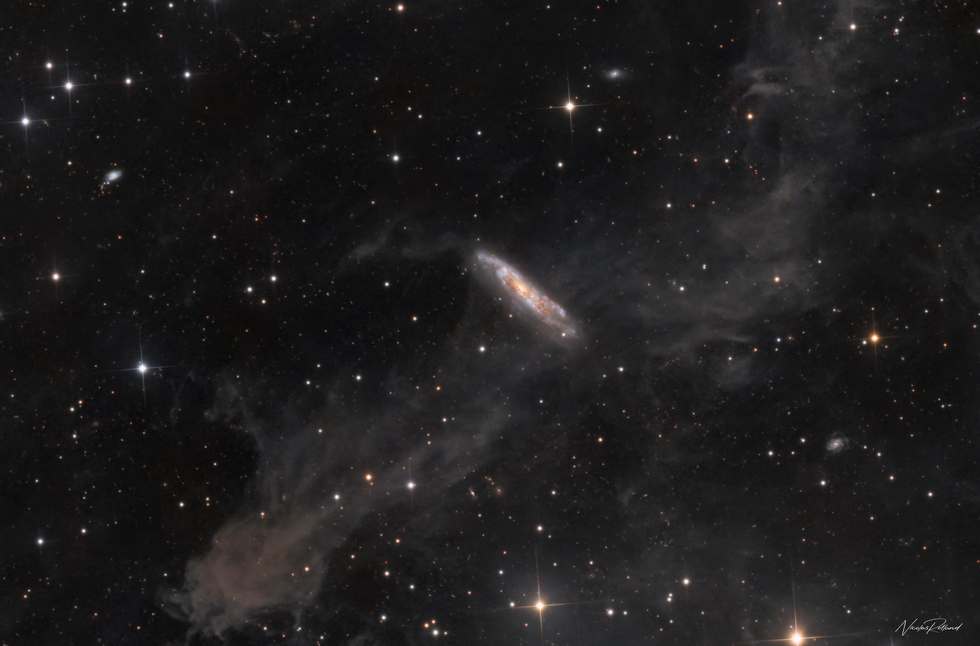A Galaxy in the Dust - NGC 7497
A Galaxy in the Dust - NGC 7497
NGC 7497 is a barred spiral galaxy located in the constellation Pegasus. Its velocity relative to the cosmic microwave background corresponds to a Hubble distance of 19.8 ± 1.4 Mpc (approximately 64.6 million light-years). Discovered by the German-British astronomer William Herschel in 1784, it was also observed by the British astronomer John Herschel in 1825.
NGC 7497 has a luminosity class of VI and a broad HI line. With a surface brightness of 14.38 mag/arcsec², it is categorized as a low surface brightness galaxy (LSB), where LSB galaxies, of diffuse (D) type, have a surface brightness at least one magnitude fainter than the ambient night sky.
Currently, twenty-two non-redshift-based measurements indicate a distance of 17.864 ± 3.715 Mpc (approximately 58.3 million light-years), which is consistent with Hubble distance values.
During visual observations, this spiral galaxy appears as a faint grayish bar. However, on extended photographic exposures, a different spectacle unfolds. The accumulation of photons reveals that NGC 7497 is, in reality, "captured" in an extensive molecular cloud named LBN 419, listed in Lynds' Catalog of Bright Nebulae, which includes 1791 bright nebulae. Molecular clouds are celestial regions where gas and dust conglomerate, primarily composed of molecular hydrogen (H2). These cold regions also serve as stellar nurseries, where new stars are born. It's worth noting that LBN 419 is actually much closer, located within our own galaxy.
RA 23h 08m 58.9s
DEC +11° 11' 37.2"
SIZE 30.5 x 20.1 arcmin
ORIENTATION Up is 184.4 degrees E of N
CONSTELLATION Pegasus
MAGNITUDE 12.2
DISTANCE 64 million ly
Captured July 2023
better resolution: https://nicolasillustrations.com/project/ngc7497-lrgb
NGC 7497 has a luminosity class of VI and a broad HI line. With a surface brightness of 14.38 mag/arcsec², it is categorized as a low surface brightness galaxy (LSB), where LSB galaxies, of diffuse (D) type, have a surface brightness at least one magnitude fainter than the ambient night sky.
Currently, twenty-two non-redshift-based measurements indicate a distance of 17.864 ± 3.715 Mpc (approximately 58.3 million light-years), which is consistent with Hubble distance values.
During visual observations, this spiral galaxy appears as a faint grayish bar. However, on extended photographic exposures, a different spectacle unfolds. The accumulation of photons reveals that NGC 7497 is, in reality, "captured" in an extensive molecular cloud named LBN 419, listed in Lynds' Catalog of Bright Nebulae, which includes 1791 bright nebulae. Molecular clouds are celestial regions where gas and dust conglomerate, primarily composed of molecular hydrogen (H2). These cold regions also serve as stellar nurseries, where new stars are born. It's worth noting that LBN 419 is actually much closer, located within our own galaxy.
RA 23h 08m 58.9s
DEC +11° 11' 37.2"
SIZE 30.5 x 20.1 arcmin
ORIENTATION Up is 184.4 degrees E of N
CONSTELLATION Pegasus
MAGNITUDE 12.2
DISTANCE 64 million ly
Captured July 2023
better resolution: https://nicolasillustrations.com/project/ngc7497-lrgb
SPECIFICATIONS
Telescope
PLANEWAVE CDK24 @ F/6.5 (CHI-1)
Camera
QHY 600M Pro
Location
El Sauce Observatory, Rio Hurtado, CHILE
Date of observation
07/2023
Filters
Luminance, Red, Green, Blue
Processing
Pixinsight, Photoshop
Credits
Processing: Nicolas ROLLAND / Data acquisition: Telescope.Live



